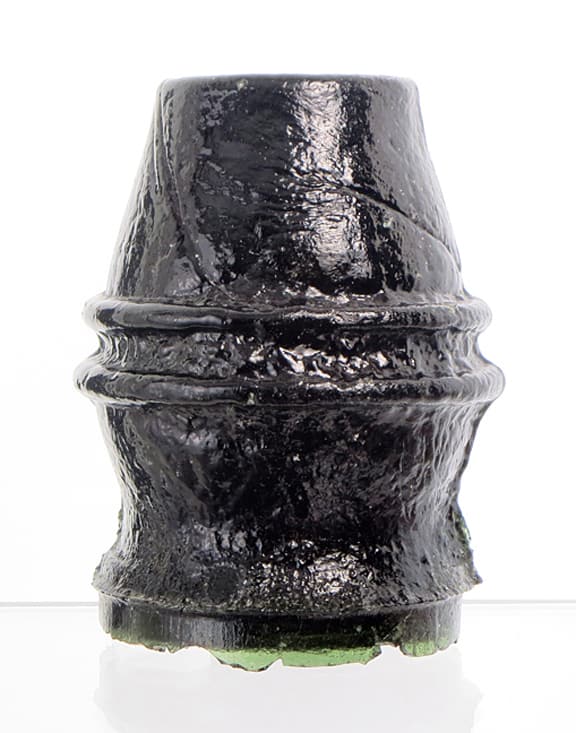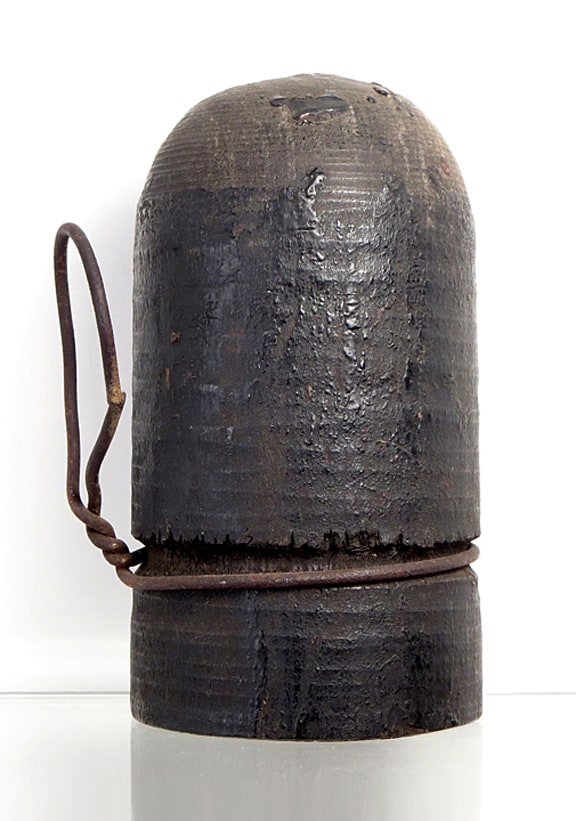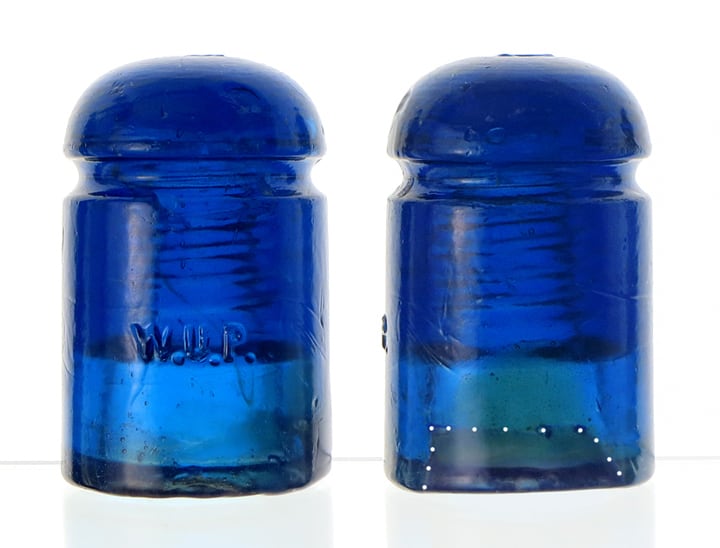 Pole Top Discoveries
Pole Top Discoveries
Auction #69 Stand-outs
![]() I really enjoy looking at the wonderful photography and descriptions that Ray Klingensmith puts together for some of his auction pieces. Today we are looking at thirteen extraordinary insulators from Pole Top Discoveries Auction #69 that closed last night. If every bottle has a story, these insulators sure do too. Thanks to Ray for such nice write-ups.
I really enjoy looking at the wonderful photography and descriptions that Ray Klingensmith puts together for some of his auction pieces. Today we are looking at thirteen extraordinary insulators from Pole Top Discoveries Auction #69 that closed last night. If every bottle has a story, these insulators sure do too. Thanks to Ray for such nice write-ups.

#301 CD 1000 Unembossed Glass Block, Bright green – The attractive, rich green glass makes these early insulators quite desirable. One of several blocks which were found during the 1960’s, stored within an old wooden box in a railroad depot in Gallatin, Tennessee. The insulators showed no sign of usage, and were probably placed in storage to be used on a nearby line. A telegraph line built through the area in the 1840’s was constructed with blocks, suggesting the Gallatin blocks may possibly have been extras from that project. Several different glass colors were discovered in the Gallatin find. Although this particular color was found in the greatest quantity, it is one of the brightest, most attractive colors. Since the discovery more than four decades ago, these historical relics have settled into collections and are seldom offered for sale. – Pole Top Discoveries | Auction #69

#303 U-970 Porcelain Threadless Egg, Unmarked, Grey-tan – Possibly made at Parr’s Pottery in Richmond, Virginia. Found at a Richmond, Virginia construction site in 1990. Local relic collectors discovered the site which was reported to be at the location of a Confederate supply depot during the Civil War. With the hasty departure of citizens and military personnel from Richmond in April, 1865, as Union forces approached, these examples were abandoned in a building which was destroyed by fire. Only a limited number of this smaller porcelain egg were recovered in comparison to larger, glass CD 701.6, also found at the site in larger quantity. Two shallow wire ridge flakes, and two on the base. Nicer condition than most. – Pole Top Discoveries | Auction #69

#305 CD 701.6 Unmarked Deep opaque green – Known as the “Confederate egg.” Discovered at a Richmond, Virginia construction site in 1990. The site reportedly was the location of a Confederate warehouse during the Civil War. As a result of the burning of Richmond in April, 1865, most examples located within a crumbled brick building were melted or destroyed. Luckily, a sizable number survived and were recovered by eager diggers. Historical significance makes these crude relics one of the most desirable insulators in the hobby today. Crudely made with an extremely textured and pebbly surface! Much nicer than most. Free of the typical internal fractures and has only a half pinkie nail dome flake. A great example! – Pole Top Discoveries | Auction #69

#308 CD 737 LEFFERTS Rich blue aqua – Bright sparkling glass. Overall, one of the very best Lefferts in the insulator hobby! The glass has great clarity and richness, and the condition is phenomenal, remaining very, very near mint. Most CD 737 Lefferts have been dug, with varying degrees of damage. An exception to the rule, this is a prime candidate for anyone who has waited for the ultimate example! – Pole Top Discoveries | Auction #69

#309 CD 723 Unmarked “Wood Covered Wade.” Wood/aqua glass – An incredible example from the Pat & Shirley Patocka collection! The entire unit remains in a fabulous state of preservation! The wood has the original thin coating of black coal tar, with well pronounced concentric lathe turnings on the wood surface. Complete with the original iron tie wire. The very near mint glass CD 723 “dot dash Wade” type insulator is firmly cemented with coal tar within the wood covering. In all respects, a museum quality example! Although no written history came with this item, it would appear the insulator was likely found in a building to remain in such wonderful condition. Few examples exist in such a wonderful state of preservation! – Pole Top Discoveries | Auction #69

#312 CD 735 U.P.R.R MULFORD & BIDDLE Green, Rare Color! Mulford & Biddle was a company which operated in New York during the 1860’s. They advertised the sale of telegraph wire, and apparently supplied other telegraph related materials as well. The insulators with additional “U.P.R.R.” embossing were produced for use on the historic, first transcontinental railroad in America. Aqua examples have been discovered on the Wyoming and Utah segments of the 1860’s line. The much rarer green examples have been found in limited numbers on short stretches of track in Wyoming. Shallow base chip and two short fractures up from the base. Of the few green units known, this one has nice depth of color and remains in better condition than most. – Pole Top Discoveries | Auction #69

#313 CD 735 U.P.R.R MULFORD & BIDDLE Rich, dark blue, Great depth of color and great condition! – Various shades and tints of blue colored glass can be found in the CD 735 U.P.R.R. This is among the richer, darker examples. Even more important is the excellent overall condition! A beauty with only a little minor flaking, this gem ranks among the top two or three blue Mulfords that Pole Top has offered for sale in the past 43 years! This high demand item surfaces on a regular basis with varying degrees of damage, but excellent examples are rarely encountered! – Pole Top Discoveries | Auction #69

#316 CD 740.7 “High Dome Canadian Hat” Unmarked, Light green, Circa 1857-1859 – A seldom encountered hat style threadless from Canada. The CD 740.7 has a base and skirt similar to that of the CD 740, but from the wire groove upward, there are some dramatic differences. The wire ridge on these units is sharply pronounced, and the dome is quite high with a flat top. This design has been found in limited numbers. Some were used on the Port Hope, Lindsay & Beaverton Railway which opened in 1857. A section of the main line Grand Trunk Railway in Southwestern Ontario also used this type. A lighter green tint, opposed to the medium green colouration sometimes seen in this style. Neat tilt to one side adds character! Bruise affects one fourth of the base. Remainder of insulator is very nice and free of any distractions or damage. – Pole Top Discoveries | Auction #69

#321 CD 743.1 Unmarked vivid yellow green – The CD 743.1 threadless “beehive” has been found primarily along Canadian railway right of ways. Some of those railways were constructed in the 1869-1872 time period, indicating this threadless style may have been produced into the 1870’s, perhaps as late as about 1875. Threadless beehives produced with aquamarine coloured glass are somewhat scarce, but can be located within the hobby without great difficulty. Locating one in vivid yellow green, however, is extremely difficult! Only three or four whole examples, and two or three broken units have been confirmed to exist. Threadless of any design in this color are rarely seen. Previously sold in Pole Top Discoveries’ March, 1992 and May, 1999 auctions. One b-b ding on the dome and a fair sized skirt chip that does not go all the way through the glass. No cracks or other damage. An ultra rare, colourful beauty! How many decades will pass before another is available? – Pole Top Discoveries | Auction #69

#331 CD 740 TILLOTSON & CO. 16 BROADWAY N.Y. Dark olive – A late 1960’s discovery, in a northeast Ohio bottle dump adjacent to a railroad controlled by the Erie Railway. The same color as the olive CD 735 Tillotson. A rarely encountered item! Perhaps less than a dozen CD 740 Tillotson are known, taking into account all known colors! Boldly embossed with “chiselled” prismatic style marking. All of the Tillotson insulators with “16 Broadway” marking exhibit great class! It is obvious L. G. Tillotson took great pride in his telegraph supply company and offered only the best of materials. Despite Tillotson’s domination in the telegraph supply industry during the 1860’s, very few of these marked threadless have surfaced. Skirt chip to the right, skirt fracture and other flakes and surface blemishes. Displays decent presently, or apply repair to have a fabulous appearing gem! The only example seen in this color! – Pole Top Discoveries | Auction #69

#341 CD 127 W.U.P 2 Rich, dark cobalt blue – Believed to have been produced by the same manufacturer as the embossed CD 132.2 S.T. Paisley, possibly in the Beaver Falls, Pennsylvania area. Exotic blue CD 127 are rarely offered for sale! Of the three or four known to have changed hands in the past 12 or 15 years, all we have seen are the lighter, sapphire toned examples. A dark cobalt, very near mint example would likely have several takers in the five figure price range. Flat chip on the front base and another on the reverse base/skirt were repaired many years ago. The resin has discolored. Although it still displays decent, a better looking repair could be made. Not a perfect example, but how many opportunities to make a purchase for one of these rarities will arise in a lifetime?

#350 CD 123 E.C & M CO S.F. Chartreuse-olive with impurities “B” mold variant. 4-1/4” height – An incredible color, enhanced even further with olive amber streaking! Base/skirt chipping on the reverse. Flat base chip. Associated fracture which extends upward from the base, and through the dome. We were not aware this color existed in an EC&M until this beauty came to light! Pat & Shirley Patocka collection.

#393 CD 181 Unmarked “Pluto” Aqua – Perhaps the best condition example in the insulator hobby!
This insulator was originally designed by R.H Pierce for use in subways on the grounds of the 1893 Chicago World’s Fair. Numerous crossarms were placed one over the other with several insulators mounted on each crossarm. One contemporary article referred to them as the “butterfly” type. The special design allowed for two wires to be held in place on each insulator. After the fair was over, demolition crews were sent in, and in all likelihood the Plutos were salvaged and re-sold to other customers. Some were installed in the 1890’s on two power lines near Silverton, Colorado, which has been the source of most of them in the hobby. In 44 years of collecting, this is by far the absolute best condition example seen! Most would call it perfect mint! Noted is an uneven spot on the base mold line, a minuscule 1/4 the size of a pinhead. Might be “in the making,” and may be a tissue thin blemish. Regardless all the technicalities, this could well be the best Pluto in existence! You see damaged examples for sale, but you don’t see them this nice!






